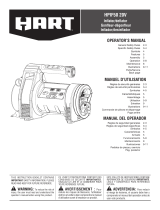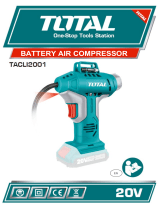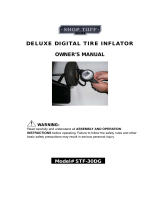Powerplus POWDP7020 Owner's manual
- Category
- Power tools
- Type
- Owner's manual
Powerplus POWDP7020 is a versatile and convenient air pressure pump, designed to inflate car and bicycle tires, as well as inflatable items for games, sports, and leisure. With its compact size and cordless design, this pump offers great portability and ease of use.
Powerplus POWDP7020 is a versatile and convenient air pressure pump, designed to inflate car and bicycle tires, as well as inflatable items for games, sports, and leisure. With its compact size and cordless design, this pump offers great portability and ease of use.










-
 1
1
-
 2
2
-
 3
3
-
 4
4
-
 5
5
-
 6
6
-
 7
7
-
 8
8
-
 9
9
-
 10
10
-
 11
11
Powerplus POWDP7020 Owner's manual
- Category
- Power tools
- Type
- Owner's manual
Powerplus POWDP7020 is a versatile and convenient air pressure pump, designed to inflate car and bicycle tires, as well as inflatable items for games, sports, and leisure. With its compact size and cordless design, this pump offers great portability and ease of use.
Ask a question and I''ll find the answer in the document
Finding information in a document is now easier with AI
Related papers
-
VARO POWX1700 Owner's manual
-
VARO POWERPLUS POWXB90080 Owner's manual
-
Powerplus POWXB90030 Owner's manual
-
Powerplus POWDP9011 Owner's manual
-
Powerplus POWPB90100 Owner's manual
-
Powerplus POWDP9062 Owner's manual
-
Powerplus POWDP9051 Owner's manual
-
Powerplus POWDP9040 Owner's manual
-
Powerplus POWDP9064 Owner's manual
-
Powerplus POWDPG7521 Owner's manual
Other documents
-
 HART HPIF50 Owner's manual
HART HPIF50 Owner's manual
-
MPG PS6616AG Installation guide
-
Ryobi YG83CR User manual
-
 Total TACLI2001 Owner's manual
Total TACLI2001 Owner's manual
-
Ryobi P747-P320 Owner's manual
-
Certa Mini Cordless Air Compressor Tyre Inflator User guide
-
Craftsman 75118 Owner's manual
-
Craftsman 120V Owner's manual
-
Makita DMP180ZX User manual
-
 SHOP TUFF Deluxe Digital Tire Inflator/Gauge Owner's manual
SHOP TUFF Deluxe Digital Tire Inflator/Gauge Owner's manual














